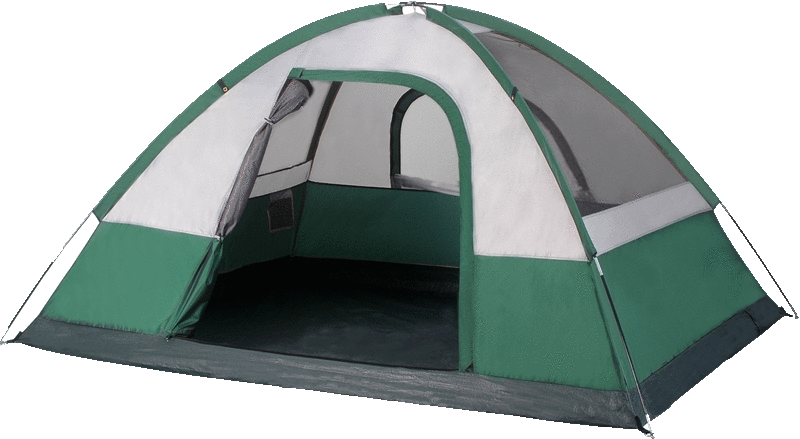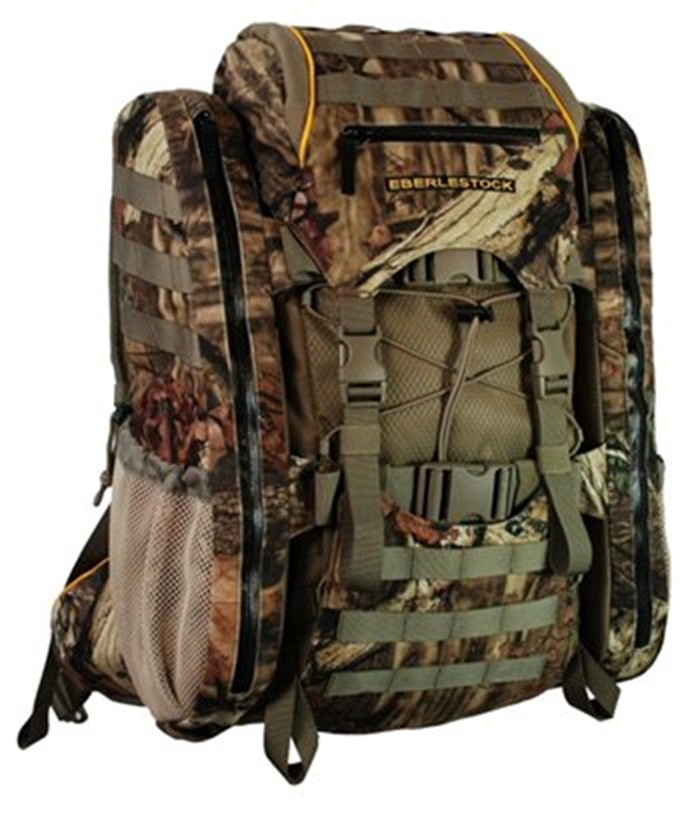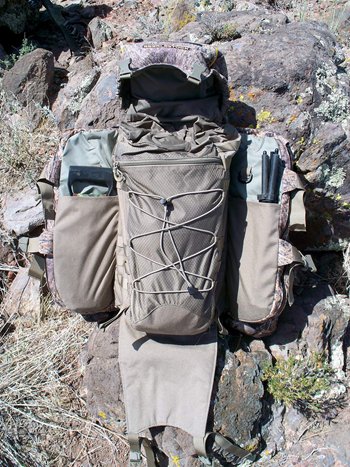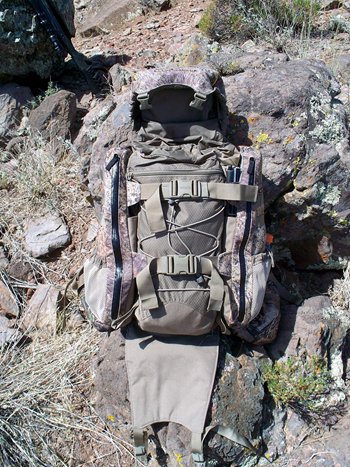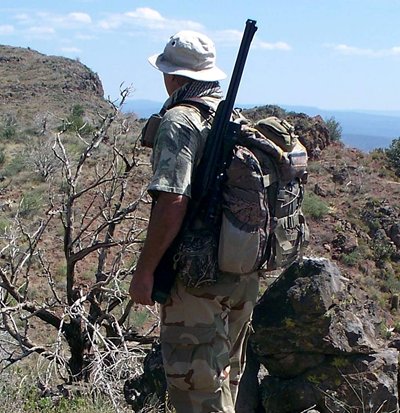The western deer hunter is a fundamentally different type of hunter than the
eastern or midwestern deer hunter. Most guys back east do a lot of sitting
in trees on a relatively small patch of land. The western big game hunter
on the other hand, spends most of his time roaming the mountains, often
ending up miles from where he parked his vehicle. The hunting daypack is
an essential piece of gear for the western hunter who must carry with him
all the essentials necessary to sustain him for a day of vigorous physical
activity. In addition, he will need to carry the necessary tools and supplies
to be able to field dress the animal. And then he must consider how he will
get the critter out of the field.
Though I sometimes hunt with my sons, I am mostly a solo hunter. That means
that I normally do not plan to have any help available to process and retrieve
my game. That takes a lot of prior thought about what to do after a critter
is down.
I’ve owned and have worn out a number of hunting packs over the years, but
this question of how to get the critter back to civilization has always been
a vexing problem.
Let me admit first of all that though I am a decent rifle shooter, I am not
a very good deer hunter. Oh, I love deer hunting the most of all Arizona
game hunting. The reasons are because deer are such challenging quarry for
me, and because I love roaming the mountains, getting up on high vantage
points, glassing the distant hills …
Excuse me … ok, I’m back.
I say that I am not a very good deer hunter because in my approximately 20
year career as a deer hunter, I’ve only come home three times with a deer.
The first one I field dressed, then dragged 1¼ miles back to camp and my
vehicle. I did think about how to get get him out of the field before I
took to the hills. I had a “Deer Sleigh’er” strapped to my pack for the
whole hunt. This is a rolled up sheet of thick plastic that you can tie
your deer to so that you are not dragging him on his hide.
Sounded like a good idea, but this is Arizona, with steep rocky hills to
go up and down. It saved the deer, but the “sleigh” ended up being a
one-time use article.
I took my second deer over two miles into the backcountry on a backpack
hunt. It was a Coues whitetail. I packed out first one half of him by
tying the meat onto my “day-and-a-half pack”. When I got to the vehicle,
I deposited the meat in a cooler and hiked back in the two miles with a
pack frame. I tied the second half on to the frame and hiked out.
Somehow, I also packed out my backpacking gear at the same time I was
packing out meat and horns. Whew!
The day-and-a-half pack I used on this backpack hunt was an internal frame
design. It was designed for a short overnight backpacking trip, not meat
hauling. So I did the best I could at tying on the meat, and it ended up
working, but it took some head scratching before I was able to secure the
meat to the pack for the hike out.
For the third deer, I was able to find a rough trail that I could get my
vehicle to within a half mile of the downed critter. Then I threw the
little Coues around the back of my shoulders and neck and carefully
“piggybacked” him out, all the while he was dripping blood on me.
I’ve tried hunting with external frame packs to be ready to haul should
the opportunity arise. But I found that hunting the hills for days with
a frame pack was horrible. Too big, uncomfortable, and I cannot sling
my rifle over my shoulder because the frame is always banging up against
the rifle.
Which is why when I saw the Eberlestock X2 at Sportsman’s Warehouse, I
just could not tear myself away from it. I tried. This is not an
inexpensive pack. The price approaches $200. But it is the solution
that I’ve been seeking for all these years.
This hunting pack has a very innovative design. It is a comfortable
daypack that can double as a meat “freighter” pack when the time comes.
It has a clever external/internal aluminum perimeter frame to give the
pack load bearing strength and structure. The frame is externally
visible, but it lies between the pack body and the pack’s suspension
system. Because of the way that it is tucked in, your rifle cannot
bang up against the frame when your rifle is slung on your shoulder.
To describe the pack, let’s open it up, start at the center, and work our
way outwards. In the center is a deep bag with a drawstring top. This is
the main storage compartment There is a zipper pouch on the front of the
bag, as well as a lashing bungee which is a good place to store a
sweatshirt, a rain jacket or other outerwear that you may want quick access
to. On the sides of the central bag is MOLLE webbing which can be used for
general purpose lashing needs or for attaching an optional rifle scabbard.
Moving to the sides, things get interesting. On each side of the central
bag are two “wing” pouches. Each wing pouch is zippered vertically and is
large enough to hold a spotting scope, or a 3 liter hydration bladder.
Each wing also has a deep open top pocket facing the central bag that is
made of sturdy canvas.
Yes, you can carry a total of 6 liters of water in 2 hydration bladders
in these side wing pouches. Hydration bladders are not included when you
buy the pack. I added my own Camelbak bladders. When I first got the X2,
I took it out for a hot desert hike of about 1½ miles for a “shakedown
cruise”. I was glad for the dual bladder capability when I stopped for a
rest break, took off the pack and laid it down on the ground.
I’ve done it before, and I’m sure that I will do it again: I forgot to
close the cutoff valve on the drinking tube when I laid it down. When I
picked it up again, I discovered that I had laid down the pack on top of
the bite valve, which allowed the entire contents of the bladder to drain
onto the parched desert dirt.
So there I was, in 100° heat, over a mile from my vehicle with an empty
water bladder - except that I had another full water bladder in reserve!
So I tucked away the tube from the now empty bladder, and pulled out the
tube from the still full bladder. I was good to go! Awesome. But a
lesson learned once again.
The two side wing pouches buckle together with two horizontal adjustable
straps to close against the center bag. The top half of the outside
surfaces of the side wings are also equipped with MOLLE webbing strips.
Each side wing also has a netting pouch with a drawstring top on the lower
half of the outside surface.
On the top of the pack is another pouch with a main zippered compartment,
and a smaller zippered compartment which is just big enough for a folding
knife and a “lenspen”. The main zippered compartment of the top pouch is
reasonably roomy. I typically keep my toilet paper in there, some light
gloves, an ear warmer, a bandana or two, a couple of granola bars, spare
ammo …
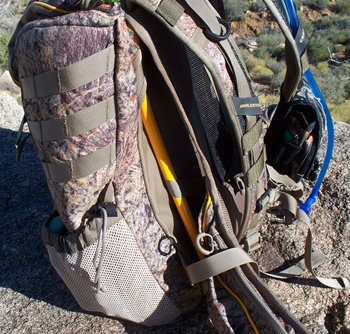
Aluminum frame and mesh
back suspension system
|
On the bottom of the pack is a flap that folds upward and buckles to the
top pouch with two vertical adjustable buckle straps. More MOLLE webbing
is available on the outside surfaces of both the top pouch and the bottom
flap. These can be used for additional lashing points, or places where
additional accessory pouches or other MOLLE compatible gear can be attached.
Isn’t this a weird design for a pack? But there is a very good reason for
this unusual design. With the two vertical, and the two horizontal buckle
straps that hold the pack in the closed position, you actually have a system
that can very easily be used to haul out a deer quarter, or even an elk quarter.
If you were to take along a small, light polyester duffel bag, about the size
of the central bag, you could transfer everything inside the pack’s center bag
to the duffel, collapse the now empty center bag against the pack’s frame, then
the side wings, the bottom flap, and the top pouch form a perfect containment
and lashing system for the animal quarter. You could easily haul out a whole
javelina this way.
I’ve had the X2 for about a year now, and unfortunately have not had the
opportunity to haul meat with it yet. But I’ve had enough days in the field
with it to take some advantage of it’s unique features. I’ve used the lashing
system to tie a blind chair and a shooting tripod to the pack. They were
mounted horizontally on the pack and lashed with the two vertical straps. The
load felt very tight and secure.
I do have two cons to report about the pack:
Unloaded, the pack weighs about 4½ pounds. So by the time I add all my stuff
for a day of humping the hills, the pack does get pretty heavy.
The good news is that the suspension system and the aluminum perimeter frame
keep the load well balanced and in control at all times. There is a very
effective hip belt (that includes two more zippered pouches) that is
un-noticeable with light loads (meaning that the load is mainly borne by your
shoulders). But with heavier loads, the weight is effectively transfered to
your hips. It’s almost magic the way it works to give you the best of both
worlds.
The second con is related to that effective suspension system. The pack has
a mesh back that provides an air space between your back and the pack body.
After several hours of hiking with a conventional day pack, my back is
usually soaked with sweat. Not so with the X2. My back stays amazingly dry.
However, because the pack is suspended off your back, you get some creaking
and squeaking of the suspension system as you twist your torso. Not a really
big deal, but noticeable.
I’ve mentioned before that I do a lot of backcountry day hiking for my other
hobby, geocaching. This is not the pack that I would choose for that. A light
and inexpensive pack from Walmart is a better choice for casual day hiking.
This is a hunting pack, and for that use, I’ve found nothing better for my needs
for western big game hunting.

![]()
